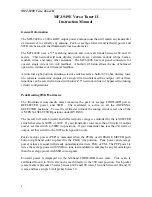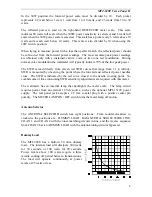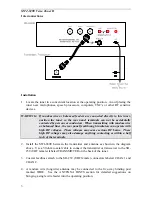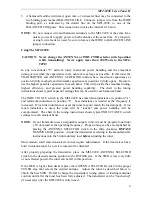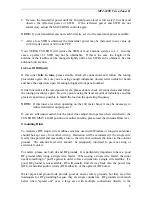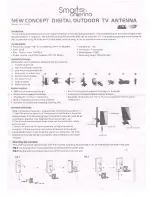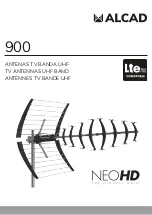
MFJ-949E Versa Tuner II
7
equipment ground point. Water pipes, heating ducts, and fences may work (especially if
they are all connected together with jumper wires), but the best RF grounds are radial
systems or multi-wire counterpoises that provide large low resistance surfaces for RF
energy. Ground rods by themselves are almost useless for dependable RF grounding.
RF and lightning travels on the surface of conductors. Braided or woven conductors have
high surface resistance to lightning and RF. Ground leads for RF and lightning should
have wide
smooth
surfaces. Avoid the use of woven or braided conductors in RF and
lightning grounds unless the lead needs to be flexible.
Antenna Hints
WARNING: For operator safety a good outside earth ground or water pipe ground
should ALWAYS be installed and connected to the case of the MFJ-949E.
Make certain the safety ground also connects to the transmitter and other
station accessories. A wing nut post marked GROUND is provided for
ground connection(s).
Location
For the best performance, an end-fed longwire wire antenna should be at least one quarter-
wavelength long at the operating frequency. Horizontal antennas should be at least a half
wave long and high and clear of surrounding objects. While good RF grounds help the
signal in almost any transmitting installation, it is extremely important to have good RF
grounds with long wire or other Marconi antennas.
Matching Problems
Most matching problems occur when the antenna system presents an extremely high
impedance to the tuner. When the antenna impedance is much lower than the feedline
impedance, an
odd quarter-wavelength
feedline converts the low antenna impedance to a
very high impedance at the tuner. A similar problem occurs if the antenna has an
extremely high impedance and the transmission line is a multiple of a half-wavelength.
The half-wavelength line
repeats
the very high antenna impedance at the tuner. Incorrect
feedline and antenna lengths can make an antenna system very difficult or impossible to
tune.
This problem often occurs on 80 meters if an odd quarter-wave (60 to 70 foot) open wire
line is used to feed a half-wave (100 to 140 foot) dipole. The odd quarter-wave line
transforms the dipole's low impedance to over three thousand ohms at the tuner. This is
because the mismatched feedline is an
odd multiple
of 1/4 wavelength long. The line
inverts
(or teeter-totters) the antenna impedance.
A problem also occurs on 40 meters with this antenna example. The feedline is now a
multiple of a half-wave (60 to 70 foot) and connects to a full-wave high impedance antenna
(100 to 140 foot). The half-wave line repeats the high antenna impedance at the tuner. The
antenna system looks like several thousand ohms at the tuner on 40 meters.


